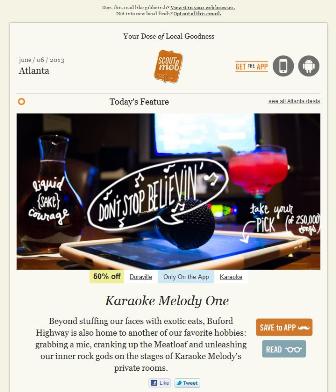 For this installment, I’ve enlisted the aid of Scoutmob’s director of email, Jarod Jones. Atlanta, Ga.-based Scoutmob sends daily emails to its entire database to promote a discount offer for a local business. In this role, Jones is well prepared to discuss how email can be a hit or miss marketing opportunity. Please read on for more about making the most of email as a marketing tool.
For this installment, I’ve enlisted the aid of Scoutmob’s director of email, Jarod Jones. Atlanta, Ga.-based Scoutmob sends daily emails to its entire database to promote a discount offer for a local business. In this role, Jones is well prepared to discuss how email can be a hit or miss marketing opportunity. Please read on for more about making the most of email as a marketing tool.
Given the amount of email most folks receive, it’s a challenge to get recipients’ attention to read and act on the emails a marketer has sent. What do you do to overcome these challenges?
Jones: Test, test, test. Our daily email gets a 2 hour subject line test every morning to make sure that we’re surfacing up the most relevant/interesting content to our subscribers. Send time testing is also key. We’ve found that a lot of industry “best practices” were completely untrue for our organization. Don’t be afraid to test and challenge assumptions, including your own. If something works for you now, it may not work for you in 6 months. As long as you’re not completely disregarding your subscribers’ expectations, changing up your subject line format or send time or even your email’s content can help recapture your audience’s interest.
Outside of the operational details, make sure you’re sending emails that are valuable to your subscribers, not your organization. The quickest way for your subscribers to disengage is receiving repetitive communications that aren’t interesting or helpful to them. They’ll start assuming that none of your emails have relevant information.
Can you explain this 2-hour subject line test that you perform?
Jones: It’s a simple A/B test. We test 2 different subject lines with different content to 2 10% segments of our list and whichever results in the most opens is sent to the remaining 80% of our list. A fantastic way to predict what content is going to drive the most engagement.
Mobile rendering is a hot topic in the email world these days. Do you find that a large percentage of your readers are viewing your messages on a mobile device or have you noticed any changes from desktop to mobile viewing?
Jones: We have seen a rise in mobile views but the desktop is still king. However, we have seen some interesting trends due to the increase in mobile views. For example, our email open rates on weekends are equal or greater to our weekday open rates, which is not something we’d expect to see. And because of this, we’ve seen our weekend site traffic from mobile users remain steady with weekday site traffic from the same group, where our desktop site traffic drops on the weekends.
You mention trying new things with your content. Have you ever divided your list into subgroups and sent different messages on the same day to test clicks?
Jones: We’ve done this a lot recently with the launch of our new e-commerce store, Shoppe. One of our top selling categories is Local Pride, so when we bring on new artists who have cool map artwork, for example, we’ll show people different products by location: Atlanta sees an Atlanta map, Los Angeles sees an LA or California map, etc. It’s not enough to show all of our subscribers an example map and add a CTA (call to action) like “see all available cities”. Showing them the most relevant product really works and these segmented emails have brought in as much as double the sales as some of our non-segmented content.
The takeaways here are:
- Test and continue to do so.
- Tactics are likely to be very fluid.
- Segmenting a list to send more relevant information can be very beneficial
- Knowing the platform viewing habits of your audience will help in planning web site content and understand if mobile viewers will click through or not

Email lessons learned from @scoutmob by @SandiSolow http://t.co/9NeZFbiXCs
Link now added: http://t.co/t1Nt0y5Wiv #emailmarketing lessons from @scoutmob